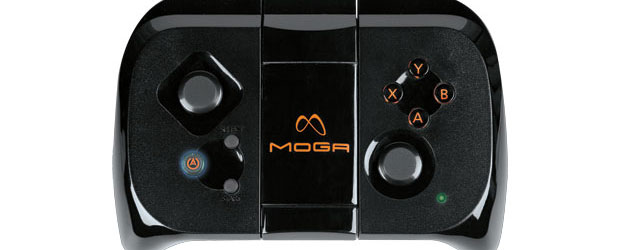[tab:Review]
In the past few years, smart phones have become a legitimate challenger to gaming devices like the Vita and 3DS. Newer, faster phones offer richer gaming experiences than was possible before, and consumers are asking themselves if a portable gaming system is really necessary if they’re already carrying a device that can perform a similar function. The big advantage of a dedicated handheld has always been the controls – most traditional games just work better with a controller than they do with touch controls. PowerA attempts to close the gap with the MOGA, a bluetooth controller for gaming on Android platforms. MOGA is a step forward for mobile gaming, but it misses an opportunity to make a big impact by not supporting non-MOGA games.
Arriving in a cool carrying bag with the logo embroidered on the front, MOGA is a nice looking piece of hardware – black with an orange MOGA logo and button accents. The device features dual analog sticks, four face buttons, two shoulder buttons and select and start buttons, making it immediately familiar to anyone who has held a controller in the last 10 years. There is also a PowerA button that handles bluetooth pairing and a dedicated on/off switch. The center portion of the controller rises up to become an arm that holds your phone in place, so there is no balancing or separate stand required.
The analog sticks on the MOGA are similar to the 3DS or PSP; they’re basically a button with 360 degree range of motion. There is more resistance than the 3DS, but the controls felt fine, and I was able to play racing games and first person shooters with no problems. The four face buttons are positioned above the right analog stick, and although I can cover all four at once with my thumb there is enough space in between them that I never had any issue pressing the button I wanted. The triggers are digital and contoured, and felt natural.
The sides of the MOGA controller are shaped similarly to the 360 controller, and fit nicely in my hands. Each grip area houses one AAA battery, and the separation keeps the controller feeling balanced, which is nice. Under the left analog stick are the start, select and MOGA buttons. The MOGA button provides bluetooth feedback, and flashes blue while searching for a device and changes to green when paired. It’s also used to wake the device when it goes to sleep, which it does after seven minutes of inactivity. PowerA claims that MOGA will get 18 hours of playtime from a set of batteries.
The center section of the controller lifts up to reveal an on/off switch, and creates an arm for holding a phone. The arm expands to fix phones up to 82mm wide, and had no problem holding the HTC One X I tested. The arm has rubber padding on the inside to protect the phone, and has enough tension that I was able to hold the phone only and swing back and forth without the controller even budging. The MOGA also had no trouble holding my HTC G2, which is significantly thicker and heavier by than the One X. The arm stays nicely folded into the controller if you’re not using it (like if you’re playing on a tablet), and doesn’t get in the way at all.
While the MOGA held both phones I tested firmly there were some minor drawbacks. Because both phones (and most phones today) have the volume controls on the side, I needed to place them in the arm off center to avoid the arm pressing the volume controls. It’s not a big problem, but it makes the view a little unnatural. Also, the arm doesn’t recline as much as I would have liked, so while holding the controller and viewing the screen was generally comfortable a little extra angle would have been nice.
PowerA’s Pivot app handles controller syncing and manages your library of games, and it’s required for using MOGA. It worked fine most of the time, although once I paired the controller with the second phone it took me a few attempts to re-pair it with the first phone again, which is something that hopefully future versions of the software will address.
A major downside to MOGA is that it only works with games that specifically support it, and it does not function as a standard bluetooth controller. As soon as I minimized Pivot to open a non-MOGA game the controller lost sync with the phone. The documentation is clear that the device does not support emulators or any other software, which is unfortunate because like a lot of people I have multiple games on my phone and tablet that would benefit from (and support) a controller. It’s a shame that a nice piece of hardware is handicapped like that, and it makes it harder to justify the price.
MOGA is a nice piece of hardware; it’s comfortable, responsive and holds a phone nicely to provide a really good mobile gaming experience. It’s really disappointing that it doesn’t work with anything outside of the limited selection of apps made for it, and it’s hard to justify spending $50 on a controller that will only support a small set of games. For what it is, it’s very good. Hopefully down the road it will open up and become something great.
Review copy of game provided by publisher.
[tab:Screenshots]
[tab:END]



Marian
the device does not support emulators or any other software…? WTF????!!?! is piece of crap!